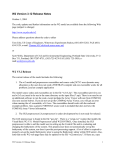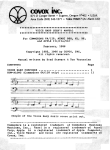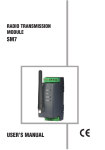Download VdS Shunt lock function 3066
Transcript
VdS Shunt lock function 3066 Version: December 2003 VdS Shunt lock function 3066 Register Deactivation unit Deactivation unit Deactivation unit Activation unit with configuration MASTER Alarm System 1.0 2.0 Functional Description ________________________________4 1.1 General Information ______________________________________ 4 1.2 Safety Remarks __________________________________________ 6 Assembly Instructions_________________________________7 2.1 General Information on Installing the Components ____________ 7 2.2 Installing the Deactivation Unit (DA)_________________________ 8 2.2.1 Testing the Deactivation Unit (DA) __________________________ 9 2.2.2 Connecting Power Supply, Lock Contact Evaluation and Sabotage Contacts: ______________________________________ 9 2.2.3 Connecting Deactivation Request and eactivation Acknowledgement ____________________________ 10 2.3 Installing the Master Activation Unit (MA) ___________________ 11 2.3.1 Testing the Master Activation Unit (MA)_____________________ 12 2.3.2 Connecting Power Supply, Switch Contacts and abotage Contacts: ______________________________________ 12 2.3.3 Connecting Deactivation Request, Deactivation Acknowledgement and Activation Request _________________ 13 VdS Shunt lock function 3066 Register 2.4 Installing the Slave Activation Unit (SA) ____________________ 14 2.4.1 Testing the Slave Activation Unit (SA) ______________________ 15 2.4.2 Connecting Power Supply, Sabotage Contacts and Local______ 15 Activation Suppression: _______________________________________ 15 2.4.3 Connecting Deactivation Acknowledgement and Activation Request _______________________________________________ 16 3.0 4.0 5.0 6.0 2.5 Wiring the Shunt Lock Components________________________ 16 2.6 Functional Principles ____________________________________ 17 Programming _______________________________________20 3.1 Programming the Activation Units (MA and SA) ______________ 20 3.2 Programming the Deactivation Units (DA) ___________________ 22 Installation _________________________________________24 4.1 Installing the Deactivation Unit ____________________________ 24 4.2 Installing the Activation Unit (MA and SA) ___________________ 25 4.3 VdS-Compliant Installation of the Activation Unit (MA and SA) _ 26 Special Versions of the Shunt lock function 3066 _________28 5.1 Operating the Activation Unit Without a Deactivation Unit _____ 28 5.2 Operating the Deactivation Unit wthout an Activation Unit _____ 28 Data Sheet__________________________________________29 VdS Shunt lock function 3066 Page 4 1.0 Functional Description 1.1 General Information In objects protected by the alarm, measures must be taken to prevent any unintentional entry of the secured area when the alarm system (burglar alarm system, BAS) is activated externally, because this would trigger a false alarm. The Shunt Lock function 3066 implements such a feature without requiring extensive work on the door or doorframe. The following components are needed for this: 1. Activation unit(s) (MA and SA) Such a unit is used to switch the alarm system. You need at least one activation unit (AU) to activate and deactivate the system externally. If you want to be able to activate/deactivate from several locations, you need the corresponding number of activation units. You can use a mouse click to issue the authorizations for activating and deactivating the alarm system in the locking plan. Basically, there is a difference between the master activation unit (MA) and the slave activation units (SA). The SAs are needed only if you want to activate or deactivate from more than one location. It is always the MA that activates or deactivates the alarm system externally using a floating contact. SAs only send the appropriate requests to the MA. You can also activate internally by using SAs that are separately connected to the internal activation connection of the burglar alarm center (BAC). 2. Deactivation units (DA) These are installed next to the doors of the secured area (and in the immediate vicinity of the digital cylinder). They see to it that these doors cannot be accidentally opened even with an authorized transponder if the alarm system has been activated externally. This reliably prevents false alarms. VdS Shunt lock function 3066 Page 5 Switching on the alarm system (burglar alarm system, BAS) The person with switching authorization presses his or her transponder near an activation unit two times in quick succession (within 2 sec.). This sends a signal to all deactivation units present. If lock contacts are connected to the deactivation units, the DAs first verifies that the doors have been correctly locked. The digital locking cylinders or Smart Relays are not deactivated unless this is the case, so that it is no longer possible to enter the secured area. The activation unit does not receive a positive acknowledgement until all lockings have been successfully deactivated. It then uses a floating contact to activate the alarm system externally (compelled signaling). The light emitting diodes of the activation units signal this by lighting for 2.5 seconds. The light emitting diode(s) on the deactivation unit(s) go out. The BAS acoustically signals – for example, on the activation unit – that the system has been successfully activated. Switching off the alarm system The person with switching authorization again presses his or her transponder twice in quick succession within transmitting range of the activation unit. The deactivation units signal this to the digital locking cylinders or the digital Smart Relays. The LEDs on the activation units visually signal that the system has been successfully deactivated by blinking 1x short-long. The LEDs on the deactivation unit(s) light again. (The LEDs on the deactivation units are used only for testing purposes, so they do not have to be brought out where they can be seen). Now it is possible to access the doors again with all authorized transponders. ☺ By simply clicking the transponder button within transmitting range of activation units, you can determine the activation state of the alarm system if the LEDs on the activation units are brought out where they can be seen. 1 x short-long blinking means "deactivated", 1 x long (2.5 sec.) blinking means "activated". Activation transponder For emergencies, you can use the locking plan software to program a transponder that cancels the deactivation of the locking cylinder so that the doors can be opened with an authorized transponder. However the alarm system remains activated externally. VdS Shunt lock function 3066 Page 6 Time zone control und access logging The activation units (master and slaves) can log activation/deactivation switches (access logging), and you can define time slots during which it is possible to activate/deactivate the system (time zone control): Access logging The activation unit stores the last 128 activations/deactivations with date, time and the user name of the transponder. You can read out the data with the programming device or over the network. Time zone control You can program activation units in such a way that authorized transponders can only switch the alarm system at certain times. Refer to the Software Operating Instructions, Chapter C 1.2 Safety Remarks Read through the assembly instructions carefully and thoroughly before installing and commissioning the Shunt lock components. They contain important information on the assembly, programming and operation. The components are built in accordance with the latest state of the technology. Use them only as instructed and when they are in perfect technical condition and are properly installed according to the technical specifications The manufacturer is not liable for damages that are caused by use that does not comply with the directions. Keep the documentation that comes with the product and system-specific notices in a safe place. Only trained experts are authorized to perform installation, programming and repair work. Soldering and connection work anywhere in the entire system must be performed only when the system is voltage-free. Soldering work must be performed with a temperature-controlled soldering iron that is electrically insulated from the power system. Observe VDE safety regulations and regulations from the local electric utility. Do not use the components in areas subject to explosion hazards or in areas with fumes that dissolve metal or plastic. DIN norms and the guidelines of VdS Class C must be adhered to. VdS Shunt lock function 3066 Page 7 2.0 Assembly Instructions 2.1 General Information on Installing the Components Always install in the protected area, for example, in the inside area behind the door, behind brickwork, etc. There are some materials, however, such as stainless steel or aluminum, that can significantly reduce the range. There may also be sources of magnetic interference near the activation or deactivation unit that also very strongly reduce the range. When making the connections, please observe the technical specifications for the activation unit and the relay (refer to Chap. 6). Failing to comply with these values can lead to interference with the function of the components or even to destruction of the components. Make absolutely sure that the polarity is correct. You can attach the components (deactivation and activation units) on the wall surface with two countersunk head screws, 3.5 x 30 mm, and two S5 plastic plugs (not included in the delivery). The two enclosed VdS adhesive labels guarantee permanent evidence if the housing is opened without authorization (sealing of the cover screws). Programming the components Program the Shunt lock components and accompanying lockings before installation. When doing this, please keep the following points in mind: • • • • Program activation units, deactivation units and locking cylinders in the same locking plan Select type Control unit for the shunt lock components During programming, supply only one component with power at a time and do not connect the cables to one another. After programming, read out the components and verify that they report correctly. Refer to Chapter 3 for more detailed information. Installing a locking that should be deactivated with the Shunt lock function Install the digital locking (Smart Relay or locking cylinder) that should be deactivated by the Shunt lock function. Follow the installation guidelines. These are under the relevant heading in the system manual. VdS Shunt lock function 3066 Page 8 2.2 Installing the Deactivation Unit (DA) + 8...16V Masse +LED - LED C NC N0 SAB0 SAB0 SAB0 SAB0 Soldering terminal assignments: 1 2 3+4 5-7 8 - 11 12 13 14 15 29 30 Supply voltage positive pole Supply voltage negative pole (ground) Connection for LED (5 volts) in outside area Not used Sabotage contacts Optional lock monitoring contact for activation suppression Deactivation request (input) Deactivation acknowledgement (output) Ground (identical to soldering terminal 2) Acoustic BAC acknowledgement (not for DA) Solder terminal for cable screen Jumper settings: Jumper B1 can be inserted any way Insert jumper B2 for maximum transmitting range Do not insert jumper B3 VdS Shunt lock function 3066 Page 9 2.2.1 Testing the Deactivation Unit (DA): To test, connect the deactivation unit to a 9-volt compound battery. Make sure that the polarity is correct. Position the deactivation unit within radio range of the digital locking: Deactivation unit Deactivation unit digital locking cylinder max. 40 cm (16 inches) digital Smart Relay min. 20 cm, max. 1 m (8 till 40 inches) The ranges depend on the structural circumstances and so will vary. Make sure that both the deactivation unit and cylinder are correctly programmed (refer to Chapter 3). Then connect soldering terminals 13 and 15 (ground) to one another. This deactivates the cylinder/Smart Relay (signal tone for cylinder) and the LED on the deactivation unit goes out. The cylinder no longer responds to transponders. When you remove the connection, the cylinder or Smart Relay is activated. The LED lights again. Repeat the tests several times until the radio link works perfectly. You can increase the range between the cylinder and deactivation unit by using FH version locking cylinders (with plastic inside knob). ☺ Once the deactivation unit successfully passes the test, you can carry out the actual permanent installation. 2.2.2 Connecting Power Supply, Lock Contact Evaluation and Sabotage Contacts: • Power supply Connect the positive pole of a direct current source between +8 ... + 16 V (recommended: +12 V) to soldering terminal 1. Note that the voltage is not permitted to exceed a value of +16 V under any circumstances. Connect soldering terminal 2 to ground. • Optional lock contact evaluation (global activation suppression) If you want the alarm system to remain inactivated until all doors of the security area are closed, meaning the bolts have been driven out, you can connect the lock switch contact to soldering terminals 12 and 15. The lock contact must be a floating electric strike. ☺ If there is no lock contact (not VdS-compliant), it is, of course, impossible to check whether all doors have been locked, which means that it is also possible to activate the alarm system if some doors are not locked. In any case, however, all cylinders must have been successfully deactivated. If there is no lock contact, simply do not connect soldering terminals 12 and 15. VdS Shunt lock function 3066 Page 10 Test the shunt lock function again after you have connected the lock switch contact. Try to deactivate the locking cylinder or Smart Relay even when the bolts have not been driven out. • External light emitting diode You can connect an external light emitting diode to soldering terminals 3 and 4 so that you have a visual display in the outside area showing whether the cylinder or Smart Relay is activated or deactivated. Maximum length of the line: 10 m (33 feet). • Switch contacts (not used) Soldering terminals 5 to 7 are not needed for the deactivation unit. • Sabotage contacts Connect these to soldering terminals 8 to 11. Solder the Rs resistor (terminating resistor or short circuit) to soldering pins X27 and X28 (refer to the drawing). Install other deactivation units, if any, according to the same plan. 2.2.3 Connecting Deactivation Request and Deactivation Acknowledgement Refer to Chapter 2.5 VdS Shunt lock function 3066 Page 11 2.3 Installing the Master Activation Unit (MA) + 8..16 V Masse +LED - LED C NC N0 SAB0 SAB0 SAB0 SAB0 Soldering terminal assignments: 1 2 3+4 5-7 8 - 11 12 13 14 15 29 30 Supply voltage positive pole Supply voltage negative pole (ground) Connection for LED (5 volts) in outside area Floating contacts for switching the alarm system Sabotage contacts Activation request from slave activation units (SAs) (optional) Deactivation acknowledgement (input) → Activation suppression when ground is applied Deactivation request (output) Ground (identical to soldering terminal 2) Acoustic activation acknowledgement by BAC (not for DA) Solder terminal for cable screen Jumper settings: Jumper connects right and middle contacts of B1: ⇒ Acoustic acknowledgement after activation release by activation unit Jumper connects left and middle contacts of B1: ⇒ Acoustic acknowledgement after final activation is done by the BAC (this is the VdS-compliant configuration). VdS Shunt lock function 3066 Page 12 The BAC must draw pin 29 to ground for the acoustic acknowledgement. Jumper B2 is inserted: ⇒ Maximum transmitting range. For VdS-compliant installation, however, you must then work with external keys to differentiate between outside and inside. (refer to 4.3 VdS-Compliant Installation of the Activation Unit). ⇒ In VdS-compliant installation, the range of the antenna extender is reduced solely by the correct use of the aluminum sleeve. (Refer to 4.3 VdS-Compliant Installation of the Activation Unit). Install the activation unit so that the distance between its antenna and other digital components is at least 1 m (40 inches). 2.3.1 Testing the Master Activation Unit (MA): Before final installation, apply voltage to contacts 1 and 2 of the activation unit (compound battery). Make sure that the polarity is correct. Do not wire the other contacts for this test. Transponder master activation unit 1 cm to max. 3 cm (.4 to 1.2 inches) This corresponds to the strongly reduced range when the screening sleeve is inserted on the antenna extender (refer to Chap. 4.3). L Make sure that all components are correctly programmed (refer to Chap. 3). Insert jumper B1 on the right. Then test whether the relay on the activation unit switches (soldering terminals 5 and 7) by operating the transponder two times in quick succession (within 0.5 ... 2 sec.). An acoustic signal indicates the switching state of the alarm system. A 2.5-second long continuous tone signals that the activation contact was closed and a two-part signal tone (short – long) means that the activation contact is open again (deactivated). Then you must convert the acoustic activation acknowledgement to BAC operation (insert jumper B1 to the left) and test it by attempting to activate the system. Once the master activation unit has successfully passed the test, you can carry out the actual permanent installation. 2.3.2 Connecting Power Supply, Switch Contacts and Sabotage Contacts: • Power supply Connect the positive pole of a direct current source between +8 ... + 16 V (recommended: +12 V) to soldering terminal 1. Note that the voltage is not permitted to exceed a value of +16 V under any circumstances Connect soldering terminal 2 to ground VdS Shunt lock function 3066 Page 13 • External light emitting diode You can connect an external light emitting diode to soldering terminals 3 and 4 for visual signaling. When the transponder is operated successfully, the LED blinks. Maximum length of the line: 10 m (33 feet). • Switch contacts Connect them to the alarm system. Soldering terminal 5 is the common contact, 6 is for the electric strike and 7 for the make contact. Refer to the BAS installer instructions for the wiring and values for the terminating resistor(s). Rx: wire jumper; Ry: wire jumper; Rz: terminating resistor • Sabotage contacts Connect them to soldering terminals 8 to 11. Solder the Rs resistor (terminating resistor or short circuit) to soldering pins X27 and X28 (refer to the drawing). • Global activation suppression (optional) Applies ground (such as pin 15 or pin 2) to pin 13 over a floating contact so that the system cannot be activated. 2.3.3 Connecting Deactivation Request, Deactivation Acknowledgement and Activation Request Refer to Chapter 2.5. VdS Shunt lock function 3066 Page 14 2.4 Installing the Slave Activation Unit (SA) + 8..16 V Masse +LED - LED C NC N0 SAB0 SAB0 SAB0 SAB0 Soldering terminal assignments: 1 2 3+4 5-7 8 - 11 12 13 14 15 29 30 Supply voltage positive pole Supply voltage negative pole (ground) Connection for LED (5 volts) in outside area Not used Sabotage contacts Optional activation suppression when ground is applied (for example, lock contact evaluation) Deactivation acknowledgement (input) Activation request to the master activation unit MA (output) Ground (identical to soldering terminal 2) Acoustic activation acknowledgement by BAC (not for DA) Solder terminal for cable screen Jumper settings: Jumper connects right and middle contacts of B1: ⇒ Acoustic acknowledgement after activation release by activation unit Jumper connects left and middle contacts of B1: ⇒ Acoustic acknowledgement after final activation is done by the BAC. The BAC must draw pin 29 to ground (VdS-compliant configuration). VdS Shunt lock function 3066 Page 15 Jumper B2 is inserted: ⇒ Maximum transmitting range. For VdS-compliant installation, however, you must then work with external keys to differentiate between outside and inside. (Refer to 4.3 VdS-Compliant Installation of the Activation Unit). ⇒ In VdS-compliant installation, the range of the antenna extender is reduced solely by the correct use of the aluminum sleeve. (Refer to 4.3 VdS-Compliant Installation of the Activation Unit). 2.4.1 Testing the Slave Activation Unit (SA): Before final installation, apply voltage to contacts 1 and 2 of the activation unit (compound battery). Make sure that the polarity is correct. Do not wire the other contacts for this test. Transponder slave activation unit 1 cm to max. 3 cm (.4 to 1.2 inches) This corresponds to the strongly reduced range when the screening sleeve is inserted on the antenna extender (refer to Chap. 4.3). L Make sure that all components are correctly programmed (refer to Chap. 3). Insert jumper B1 on the right. Then test whether the relay on the activation unit switches (soldering terminals 5 and 7) by operating the transponder two times in quick succession (within 0.5 ... 2 sec.). Then you must convert the acoustic activation acknowledgement to BAC operation (insert jumper B1on the left) and test it by attempting to activate the system. Once the slave activation unit successfully passes the test, you can carry out the actual permanent installation. 2.4.2 Connecting Power Supply, Sabotage Contacts and Local Activation Suppression: • Power supply Connect the positive pole of a direct current source between +8 ... + 16 V (recommended: +12 V) to soldering terminal 1. Note that the voltage is not permitted to exceed a value of +16 V under any circumstances. Connect soldering terminal 2 to ground. • External light emitting diode You can connect an external light emitting diode to soldering terminals 3 and 4 for visual signaling. When the transponder is operated successfully, the LED blinks. Maximum length of the line: 10 m (33 feet). VdS Shunt lock function 3066 Page 16 • Switch contacts Soldering terminal 5 to 7 are not needed for the slave activation unit unless you want to use the SA for internal activation. In this case, wire the SA separately from other activation units. Connect soldering terminals 5 to 7 to the internal activation connection of the BAC. Refer to the BAS installer instructions for wiring information. • Sabotage contacts Connect them to soldering terminals 8 to 11. Solder the Rs resistor (terminating resistor or short circuit) to soldering pins X27 and X28 (refer to the drawing). • Optional local activation suppression If you want to use activation suppression, connect a floating contact between soldering terminals 12 and 15. When the contact is closed, it is impossible to activate or deactivate the system locally (from this SA). This has no effect on the activation behavior of other activation units. 2.4.3 Connecting Deactivation Acknowledgement and Activation Request Refer to Chapter 2.5. 2.5 Wiring the Shunt Lock Components We recommend that you use the following types of lines: J-Y(ST)Y 6 or 8 pin, Ø 0.6 mm. The diameter should be fit to the length of the line so that the minimum voltage for the components never falls below +8 volt (voltage drop on the line). ATTENTION: You should always shield longer lines. Connect the deactivation request, deactivation acknowledgement and activation request to one another according to the drawing below. Also connect the supply voltage everywhere (pins 1 and 2, with the positive on 1 and ground on 2). Make sure that the polarity is correct. Then measure the voltage on all units and make sure that the voltage never falls below a value of +8v and never exceeds +16V. BAC Deactivation Activation request Pin 14 DA Pin 13 Pin 14 DA Pin 13 Deactivation request Pin 14 Pin 14 MA DA Pin 13 Pins 5,7 Pin 13 Pin 14 SA Pin 12 Pin 13 Pin 14 SA Pin 13 VdS Shunt lock function 3066 Page 17 Deactivation request Deactivation acknowledgement Activation request Activation suppression Supply voltage positive Supply voltage ground DA MA SA 2.6 DA MA SA Solder pin 13 Solder pin 14 Solder pin 12 Solder pin 1 Solder pin 2 Solder pin 14 Solder pin 13 Solder pin 12 Solder pin 1 Solder pin 2 Solder pin 13 Solder pin 14 Solder pin 12 Solder pin 1 Solder pin 2 = Deactivation unit = Master activation unit = Slave activation unit Functional Principles 1. A DA deactivates a neighboring cylinder if the deactivation request line (pin 13) is drawn to ground potential by the MA or the BAC. 2. A DA reactivates a neighboring cylinder as soon as the deactivation request line (pin 13) is high-impedance, which means that the MA output (pin 14) and the corresponding BAC output must both be high-impedance. 3. A DA draws the deactivation acknowledgement line (pin 14) to ground as long as its neighboring cylinder is activated or as long as the lock monitoring input (pin 12) is connected to ground. Therefore, a lock contact must be an electric strike between ground and pin 12 that opens when the bolt is pushed forward. 4. Consequently, the deactivation acknowledgement line does not go to highimpedance until each deactivation unit has successfully deactivated its neighboring cylinder and, if there is lock contact evaluation, all bolts have been pushed forward. 5. An MA draws the deactivation request line (pin 14) to ground potential after someone authorized to activate the system operates the transponder. This causes each DA to start to deactivate its cylinder. If the MA receives a positive deactivation acknowledgement within no more than 10 sec. (deactivation acknowledgement line goes high-impedance), a floating contact is closed between pin 5 and pin 7. This requests the BAC to activate the system. 6. When someone authorized to activate the system operates the transponder again, the floating contact between pins 5 and 7 is separated immediately, so that the BAC is requested to deactivate. Then the deactivation request line (pin 14) is set to high-impedance. The DAs then start to reactivate unless the BAC continues to draw the deactivation request line to ground potential in order to prevent the cylinders from reactivating (for example, until the system deactivation is complete). VdS Shunt lock function 3066 Page 18 7. Instead of operating the transponder at the MA, the slave activation units (after transponder activation at the SA by someone authorized to activate the system) can trigger an activation or deactivation process with a "highimpedance – ground potential – high-impedance" pulse on the activation request line (pin 14). Connecting plan (example with one MA and 2 DAs) BAC MA 12 V DA1 DA2 VdS Shunt lock function 3066 Page 19 After you have completed the installation work, carry out a function test. Do this by operating an authorized transponder near the activation unit twice in quick succession. The light emitting diodes on the activation unit and the deactivation unit(s) go out and you receive the acoustic acknowledgement signal from the BAC or (if jumper B1 is inserted on the right) the signal lasting 2.5 seconds from the activation unit indicating that the alarm system has been activated. Check whether the cylinder(s) or Smart Relay(s) have been deactivated. Operate the transponder near the activation unit two times again. This unit signals the activation of the lockings only visually on the LED with 1 x short-long blinking or (if jumper B1 is inserted on the right) with a double signal tone from the activation unit. The LEDs on the shunt lock components light again. The locking cylinder or Smart Relay is now active and can be switched if you operate an authorized transponder one time. Please set the acoustic activation acknowledgement to BAC operation (insert jumper B1 on the left) if you have not done this yet. Test the Shunt lock function several times. VdS Shunt lock function 3066 Page 20 3.0 Programming 3.1 Programming the Activation Units (MA and SA) If you want to add the shunt lock components at some time after the initial installation, open your locking plan with the password. If this is the initial installation, create a new locking plan. Click the locking above which you want to add an activation unit. Select New Locking. Then give the activation unit a name: For example, Alarm system In the field Type, select Control unit. Click OK & Exit or OK & Next, if you want to set up additional activation units (slaves). VdS Shunt lock function 3066 Page 21 In the locking plan, make a cross by the employees who are authorized to turn the alarm system on and off. ☺ You do not have to reprogram the transponders in this case. Approve your locking system and program the activation unit under Programming Locking. The activation unit needs supply voltage during the programming. You can provide this with a 9-volt compound battery, for example. Program activation unit(s) and deactivation units separately from one another. Do not wire the two components until after you have programmed them successfully. VdS Shunt lock function 3066 Page 22 3.2 Programming the Deactivation Units (DA) Click the line in the locking plan above the one where you want to add a deactivation unit. Select New Locking. Then give the deactivation unit a name: Such as Deactivation unit, main entrance In the field Type, select Control unit. Click OK & Exit. If you want to set up additional deactivation units, repeat these steps. ☺ If you always add the deactivation units above the accompanying digital locking cylinder, you will have a better overview of the system. Deactivation units do not need any authorizations which means that you do not have to insert any crosses. Approve your locking system and program the deactivation units under Programming Locking. The deactivation unit needs supply voltage during the programming. You can provide this with a 9-volt compound battery, for example. Program activation unit(s) and deactivation units separately from one another. Do not wire the two components until after you have programmed them successfully. VdS Shunt lock function 3066 Page 23 Read out the shunt lock components: Programming Read unknown locking. The type of the component (deactivation unit or activation unit) is displayed. Attention: The display treats slave activation units as normal Smart Relays. VdS Shunt lock function 3066 Page 24 4.0 Installation 4.1 Installing the Deactivation Unit Install the deactivation unit DA in the immediate vicinity of the digital locking cylinder (no farther than approximately 30 cm or 12 inches). This guarantees optimum transmission traffic. Align the deactivation unit so that both fastening screws lie in a horizontal line. Then the antennas point directly to the locking cylinder (refer to the drawing below). ☺ You can always achieve better ranges if you use FH cylinders (plastic knob instead of stainless steel). VdS Shunt lock function 3066 Page 25 4.2 Installing the Activation Unit (MA and SA) You should install the activation unit (AU), no matter whether it is a master activation unit MA or slave activation unit (SA), above the door case and above the locking cylinder. In any case, the distance to other SimonsVoss components must be at least 1 m or approximately 40 inches (refer to the drawing). Only in this way can you rule out mutual interference influences. If you install it above the door case, align the activation unit so that the two fastening screws lie in a horizontal line. This eliminates interference when the door is used in the normal way. (Refer to the drawing below.) This installation is done without the antenna extender and with jumper B2 is inserted (max. range). Because this (simple) installation method allows the system t AU Min. 100 cm (40 inches) Max. 30 cm (12 inches) DA Digital cylinder VdS Shunt lock function 3066 Page 26 4.3 VdS-Compliant Installation of the Activation Unit (MA and SA) VdS-compliant installation must guarantee that the system can be activated from the outside, but not from the inside. This requires the following measures: 3. Use activation units with antenna extender. Shorten the color-coded cable on the antenna extender to the required length, pull the cable through the bore hole in the aluminum screening sleeve and connect the cable to soldering connections 16 to 20 as follows: 16 - green, 17 - blue, 18 - screening, 19 - red, 20 - yellow. 4. Insert jumper B2! The range of the antennas is reduced if you use the aluminum sleeve correctly. Bore a blind hole (∅ 23 mm) in the outside wall, insert the antenna extender in the blind hole and fix in position. (See drawing below). While doing this, make sure that you get within at least 2 cm (approximately 3/4 inch) of the front side of the antenna extender from the outside and that you guarantee a minimum distance of at least 12 cm (4 3/4 inches) to the front side of the antenna extender from the inside. This is approximately the thickness of the wall. The distance between the antenna and activation unit must be at least 30 cm (12 inches) and the distance from the locking cylinder to the antenna must be at least 1 m (40 inches). 5. We recommend that you mark the position of the blind hole on the outside wall with a red point or similar marking. The person authorized to activate the system must hold the transponder at this point in order to be able to communicate with the antenna extender. Outside wall Inside wall Antenna extender Activation unit 6. Install the deactivation unit according to the description in Chapter 4.1. VdS Shunt lock function 3066 Page 27 7. You can also optionally use an activation unit without antenna extender. Install it as described in Chapter 4.2. In order to guarantee that the system can be externally activated from the outside only, you must then install a button in the outside area. You cannot externally activate or deactivate the system by operating a transponder until this button is pushed. The deactivation acknowledgement input (pin 13) is suppressed on master activation units (MAs) as long as it is connected to ground (normally closed button in outside area). A Schottky diode decouples the deactivation acknowledgement line (see below). This diode is needed, however, only if there are slave activation units. With slave activation units (SAs), you can apply the activation suppression (pin 12) to ground over a normally-closed button that is in the outside area. If there is also an activation suppression button on the master, you should use a circuit according to the figure below. BAC Deactivation Activation request Pin 14 DA Pin 13 Pin 14 DA Pin 13 Pin 14 Pin 14 MA DA Pin 13 Pins 5,7 Pin 14 Pin 14 SA Pin 13 SA 12 Pin 13 Schottky diode 1N5817 Deactivation request Electric strike in outside area Electric strike in outside area Pin 12 VdS Shunt lock function 3066 Page 28 5.0 Special Versions of the Shunt lock function 3066 5.1 Operating the Activation Unit without a Deactivation Unit If you want to activate and deactivate the burglar alarm system externally with the transponder instead of with a key, you only need a master activation unit (MA). In this case, however, you will lose the true purpose of the Shunt lock function. You need to connect only pins 1 and 2 for the power supply, the floating switch contact (pins 5, 6, 7) and the sabotage contacts (pins 8 to 11). Do not connect the other lines of the activation unit (refer to Chapter 2.3). 5.2 Operating the Deactivation Unit without an Activation Unit If you continue to operate the alarm system with a standard key, you can do without the activation unit. Connection assignment Connect the supply voltage (separate power supply) to soldering terminals 1 and 2. Connect terminals 13 and 15 over a relay contact of the alarm system (floating make contact). If there is a lock switch contact, wire this to soldering terminals 12 and 15 (Refer to Chapter 2.2). ☺ As long as soldering terminals 13 and 15 are connected to one another, for example, by a relay point of the alarm system, all digital locking cylinders equipped with a deactivation unit are deactivated. This means it is not possible to accidentally go through these doors when the alarm system is activated. VdS Shunt lock function 3066 Page 29 6.0 Data Sheet MA, SA and DA Operating voltage Current consumption 8 to 16 volts DC < 30 mA Applied relay Max. continuous current for switching output Max. switch on current Max. switching voltage Max. switching capacity 1A 1A 40 V AC 30 W / 60 VA Tamper contact 1 A / 30 V DC Make contact Transponder range with extended antenna 1 - 3 cm (.4 to 1.2 inches) Temperature range -10°C to +55°C (14°F to +131°F) Degree of protection VdS environmental class II Housing Material Color Dimensions [L/W/H] S-B or A-B-S White 85 x 85 x 26 mm Article description _________________ Article number _________________ VdS no. G 101 160





































